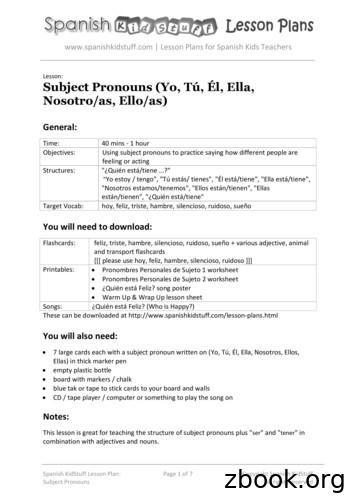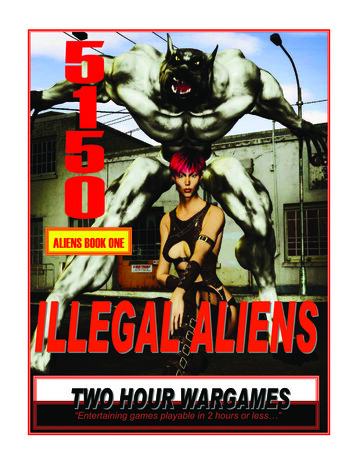Aliens’ Behaviour Connectives Game - Collaborative Learning
Aliens’ BehaviourConnectives GamebecauseA GropeNOT MUCH EVIDENCETHAT METALINGUISTICGAMES HELP IMPROVEWRITING.Help the phonicallyregular aliens finishtheir sentences!althoughLOTS OF EVIDENCE THAT PLAYINGMETALINGUISTIC GAMES HELPS BRAINTO GROW BIG AND behaviourconnectivesgame.pdfRixes love to read. they willsettle very quietly inthe book corner.while. Blimps areeating, they make aloud beeping sound.A Glimp
Aliens' Behaviour Connectives GameThis game was originally developed in 2006 for Year 5/6 at Dunkirk Primary School in Nottingham. It has also beenused at KS3. We have chosen this topic because we hope it will encourage children to produce their own alien names (auseful use of phonically regular nonsense words!), portraits and sentences. Some of the connectives are placed at thebeginning of the sentence to demonstrate that their 'glue' works at a distance.The connect four game is printed both ways round so you can have the connectives on the board or onthe cards. Children can decide which way works best. We hope they produce their own versions of thegame. We are still short of alien pictures so please send us more and we will feature them. We haveprovided scaffolding to help children produce their own sentences about aliens.\The webaddress for this activity is:A aviourconnectivesgame.pdfThis activity was last updated 21st June 2017.COLLABORATIVE LEARNING PROJECTProject Director: Stuart ScottSupporting a cooperative network of teaching professionals throughout the European Union to develop and disseminate accessible teaching materials in all subject areas and for all ages.17, Barford Street, Islington, London N1 0QB UK Phone: 0044 (0)20 7226 8885Website: http://www.collaborativelearning.orgBRIEF SUMMARY OF BASIC PRINCIPLES BEHIND OUR TEACHING ACTIVITIES:The project is a teacher network, and a non-profit making educational trust. Our main aim is to develop and disseminate classroom tested examples of effective group strategies across all phases and subjects. We hopethey will inspire you to develop and use similar strategies in other topics and curriculum areas. We run teacher workshops, swapshops and conferences throughout the European Union. The project publishes a catalogueof activities plus lists in selected subject areas, and a newsletter available on the internet: “PAPERCLIP’.*These activities were influenced by current thinking about the role of language in learning. They are designed to help children learn through talk and active learning in small groups. They work best in mixed classes wherechildren in need of language or learning support are integrated. They are well suited for the development of speaking and listening . They provide teachers opportunities for assessment of speaking and listening and otherformative assessment.*They support differentiation by placing a high value on what children can offer to each other on a particular topic, and also give children the chance to respect each other’s views and formulate shared opinions which theycan disseminate to peers. By helping them to take ideas and abstract concepts, discuss, paraphrase and move them about physically, they help to develop thinking skills.*They give children the opportunity to participate in their own words and language in their own time without pressure. Many activities can be tried out in mother tongue and afterwards in English. A growing number ofactivities are available in more than one language, not translated, but mixed, so that you may need more than one language to complete the activity.*They encourage study skills in context, and should therefore be used with a range of appropriate information books which are preferably within reach in the classroom.*They are generally adaptable over a wide age range because children can bring their own knowledge to an activity and refer to books at an appropriate level. The activities work like catalysts.*All project activities were planned and developed by teachers working together, and the main reason they are disseminated is to encourage teachers to work effectively with each other inside and outside the classroom.They have made it possible for mainstream and language and learning support teachers to share an equal role in curriculum delivery. They should be adapted to local conditions. In order to help us keep pace withcurriculum changes, please send any new or revised activities back to the project, so that we can add them to our lists of ensbehaviourconnectivesgame.pdf
Aliens' Behaviour Connectives Connect Four BoardHow to PlayThis game is best played one pair against another. You need two different colour sets of the unfinishedsentence cards. Shuffle the cards and place in two piles face down. Pairs take turns to pick a card for theircolour, and place it on the board. Everyone has to agree that the connective makes a sensible sentence. Thepair with the first four cards in a line vertically, diagonally or horizontally wins.A QuigA BlimpA GropeA NardleA GrergA GlargA Tharginstead ofwhenbecausealthoughbutafterunlesssoeven thoughbecauseThis is the top half of the connect four board which you need to glue to the bottom half using this as the haviourconnectivesgame.pdf
This is the bottom half of the connect four board which you need to glue to the top half after you have cut this bit off.ifwhenevereven ifeven whenas soon asas soon asuntilwhenbutifwheneverbecausewhileuntilinstead ofuntilwhenwhilesoeven iourconnectivesgame.pdf
Aliens' Behaviour Connect Four Game Cards. Glargscome into a room, theytwirl their antennaefive times. Blimps areeating, they make aloud beeping sound. Gropeshave ten mouths,they don't eat verymuch. a Grergsees a Glump, it greetsit by waving all itstoes. a Noop iseating, it is totallyinvisible. Nardleshave wheels and sails.they can travel fasterthan Sloshes. a Thargfeels unhappy, it willmake a gargling sound. Karks are verysmall, they haveextremely loud voices.You can't see aKongle . you wearred glasses.A Quig does not sing. it meets anotherQuig. you walk up to aTink waving a whiteflag it will spray youwith water.A Plip never flies .it is cold or raining.A Crung will wave toyou . you appear inthe distance.Toofs are very happyaliens . they lookvery gloomy and sad.Don't laugh at a Noo. it is cleaning itsflying saucer.Togs have heavy feet. their planet Zinghas low gravity. a Plong gives you apurple hat, you shouldput it on your head.Don't touch the greenspots on a Strig .they invite you to.Trugs like to jump longdistances . theyhate skipping.Nobody talks toQueeps . theystop glowing purple.Cloons do not like ourplanet . theythink we talk too loud.Tiffs fly very fast. they like tostop and chat.Rixes love to read. they willsettle very quietly inthe book corner.Sligs like to slideunder the door .opening viourconnectivesgame.pdf. Yuks are verystrong, they don't likelifting things.
Aliens' Behaviour Unfinished Sentences Connect Four BoardHow to PlayThis game is best played one pair against another. You need two different colour sets of the connectivescards. Shuffle the cards and place in two piles face down. Pairs take turns to pick a card for their colour, andplace it on the board. Everyone has to agree that the connective makes a sensible sentence. The pair withthe first four cards in a line vertically, diagonally or horizontally wins.A QuigA GropeA BlimpA NardleA GrergA GlargA Tharg. Gropeshave ten mouths,they don't eat verymuch.A Quig does not sing. it meets anotherQuig. Blimps areeating, they make aloud beeping sound. Nardleshave wheels and sails,they can travel fasterthan Sloshes. a Grergsees a Glump, it greetsit by waving all itstoes.You can't see aKongle . you wearred glasses. Glargscome into a room, theytwirl their antennaefive times. a Thargfeels unhappy, it willmake a gargling sound. Karks are verysmall, they haveextremely loud voices. a Noop iseating, it is totallyinvisible.This is the top half of the connect four board which you need to glue to the bottom half using this as the haviourconnectivesgame.pdf
This is the bottom half of the connect four board which you need to glue to the top half after you have cut this bit off. a Twingle snortsit is saying hello.A Crung will wave toyou . you appear inthe distance. Yuks are verystrong, they don't likelifting things.Cloons do not like ourplanet . theythink we talk too loud.Tiffs fly very fast. they like tostop and chat.Wait . a Hubbleraises all six armsbefore leaving theroom.A Plip never flies .it is cold or raining.Rixes love to read. they willsettle very quietly inthe book corner.Sligs like to slideunder the door .opening it.Trugs like to jump longdistances . theyhate skipping.Loogs from PlanetCringle eat fish .hate greenvegetables. you walk up to aTink waving a whiteflag it will spray youwith water.Nobody talks toQueeps . theystop glowing purple. a Plong gives you apurple hat, you shouldput it on your head.Don't touch the greenspots on a Strig .they invite you to.A Stroop willdisappear . yousneeze.Squips have eyes ontheir arms . intheir heads.Toofs are very happyaliens . they lookvery gloomy and sad.Togs have heavy feet. their planet Zinghas low gravity.Don't laugh at a Noo. it is cleaning itsflying behaviourconnectivesgame.pdf
Aliens' Behaviour Connect Four Game Cardsifeven ifas soon aswheneverwheneven whenuntilbutinstead ofalthoughwhenwhilebecauseaftereven thoughsoinstead ofsobutas soon ivelearning.org/aliensbehaviourconnectivesgame.pdf
My Aliens Connectives nsbehaviourconnectivesgame.pdf
tiStarshipSibbThrubsPlanetThrumvery bigearsbig irytentacleswave alotlive inwaterglow inthe darkTringsPlanetXobogoinvisiblesnort ten armsgarglesneezeSneedlesPlanetPongGlipsThis kit needs more pictures and more informationAliens Connectives Writing Kitbounce veryhighchange fromred to blue toredgrow extraarmsfloat in the airdig deep holeswash flyingsaucers
Aliens' Behaviour Connectives Game This game was originally developed in 2006 for Year 5/6 at Dunkirk Primary School in Nottingham. It has also been used at KS3. We have chosen this topic because we hope it will encourage children to produce their own alien names (a useful use of phonically regular nonsense words!), portraits and sentences .
Truth tables for basic logical connectives ! not, and, or, xor, implies 2. Truth table for new/made-up connectives 3. "Step-by-step" truth tables for complex propositional formulas 2 1. Truth table for basic logical connectives 3 not, and, or, xor, implies Logical connectives math Java/C !and p q p && q
3.1 – Statements and Logical Connectives 1) List the dominance of connectives from the most dominant to the least dominant. Indicate whether the statement is a simple statement or a compound statement. If it is a compound statement indicate whether it is a negation, co
ALIENS 3 a Cap. 9. Acts 48 of 1964 25 of UBI. THE ALIENS ACT [28zh February, 1946.1 S. 11. PART 1. Preliminary 1. This Act may be cited as the Aliens Act. Short title lntcrpreta- tim. 2. In this Act- “embark” includes departure by any form of conveyance; “Hedth Officer” means any registered medical piactitioner
the adjectives and subject pronouns from the song. Before class, download and print off the reader "Aliens on Planet Zorg" from our website. As you go through each page, point to the pictures and try to elicit the adjective and subject pronoun for the aliens, for example: Teacher: (pointing at the aliens on page 3) What color are these aliens?File Size: 652KB
“Aliens Book” for 5150. Illegal Aliens sets the pattern for future projects. These books will introduce the player to eight new alien races for 5150. Each book will present a number of unique aliens. The description for each alien will include the following: Who they are. T
out that behaviour comes about from an interaction of ‘capability’ to perform the behaviour and ‘opportunity’ and ‘motivation’ to carry out the behaviour. New behaviour or behaviour change requires a change in one or more of these. As COM-B is an overarching framework of behaviour, it can supplement the CBT model in PWP
Health-seeking behaviour practice is recognised as an essential tool to prevent the menace of hypertension. The association among health and human behaviour is a major area of interest in public health. Kasl and Cobb 1966 identified three types of health behaviour: preventive health behaviour, illness behaviour, and sick-role behaviour.
Type A02 : Cable suffices This type comprises people with some limited interest in electronic technologies but who have neither the education nor income to become heavily engaged in using them. Many of this type are men who have recently retired or who are approaching retirement. A high proportion has access to cable television. Type A03 : Technology as fantasy This type contains many old .






















